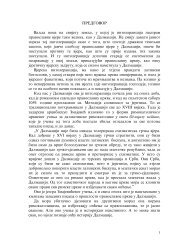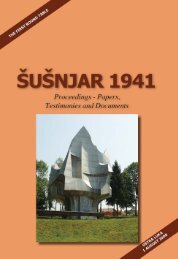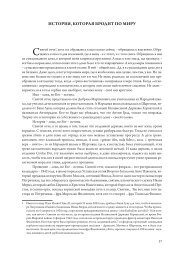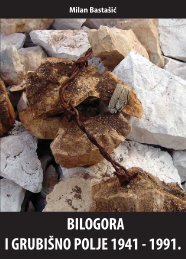Српске жртве Сребренице 1992-1995 - Srebrenica historical project
Српске жртве Сребренице 1992-1995 - Srebrenica historical project
Српске жртве Сребренице 1992-1995 - Srebrenica historical project
You also want an ePaper? Increase the reach of your titles
YUMPU automatically turns print PDFs into web optimized ePapers that Google loves.
SERBIAN VICTIMS OF SREBRENICA, <strong>1992</strong>–<strong>1995</strong>English SummaryIn order to arrive at a comprehensive understanding of events in the regionof <strong>Srebrenica</strong> during the Bosnian war in the 1990s, the treatment of the Serbianpopulation in areas surrounding <strong>Srebrenica</strong> by Army of Bosnia and Herzegovina(ABiH) forces operating from inside the enclave must be taken into account.“<strong>Srebrenica</strong>”, as it has come to be known in emotionally and politically chargedjargon, is not just three days in July of <strong>1995</strong>, but also the three preceding yearsof warfare.This monograph is a systematic effort to shed factual light on that ignoredand in many ways taboo aspect of <strong>Srebrenica</strong>’s wartime history. It consists of 50chapters in which ABiH attacks on Serbian villages surrounding <strong>Srebrenica</strong> andtheir consequences are detailed. During those attacks, hundreds of Serbian civilianswere killed. Dozens of Serbian villages were devastated and they continueto be visibly in that condition today, over a decade and half after the conflict.Statements by surviving victims of these attacks and official records are the principalsources of evidence used here. Based on data from these and other sources,a tentative list of 705 Serbian civilian victims of ABiH attacks has been compiledand is appended to this monograph.Serbian victims of these military expeditions of ABiH forces from the enclaveof <strong>Srebrenica</strong>, specifically the 28 th Division under the command of NaserOri}, include persons of both sexes and their age structure ranges from the earlyteens into the eighties. Those victims who were not killed were expelled fromtheir places of residence or were compelled to flee because they faced an imminentthreat to their physical safety. Neither the very young, the old, the infirm, orother obvious non-combatants were spared. It should be noted that in the courseof those attacks community infrastructure such as churches, cemeteries, schools,and agricultural equipment — the cultural basis for the sustainable life of Serbsas a group in <strong>Srebrenica</strong> — was systematically destroyed or desecrated, presumablyin order to prevent the return of the expelled population and to obstruct therevitalisation of their community. The only discernible pattern in this processwas that the victims were targeted principally on the basis of their ethnicity.The cumulative effect of this monograph is to raise a number of moral, political,and legal issues which do not conform easily to the dominant narrativeabout “<strong>Srebrenica</strong>”.On the moral level, there is the regional destruction of an entire community,in this case the Serbs, which has not provoked the degree of interest andcondemnation within the international community which it obviously merits.According to incomplete data presented in this monograph, between <strong>1992</strong> and<strong>1995</strong> at least 705 civilians of Serbian ethnicity were killed by ABiH forces in the
















